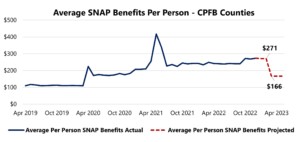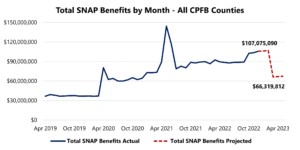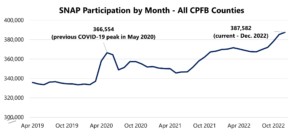Policy Brief: The End of SNAP Emergency Allotments in the Central Pennsylvania Food Bank Service Territory
Main Findings
SNAP Emergency Allotments (EAs), one of the final remaining major direct government assistance programs enacted at the start of the pandemic, will end in February 2023, a result of the omnibus spending bill passed by Congress and signed by the President in December 2022.
Average monthly benefits per person across the Central PA Food Bank (CPFB)’s Service Territory are projected to fall by $105, from $271 to $166. This is an average drop of 39%.
Cumulative monthly benefits are expected to fall by $40.7 million per month across all 27 counties, from $107.0 million in February 2023 to $66.3 million in March 2023. The expected drop in benefits is also occurring at a time when the number of SNAP participants in the CPFB service territory, 387,582 people in March 2022, has reached an all-time high and is more than 20,000 people higher than the May 2020 pandemic peak of 366,554 people.
This drop in benefits will likely increase demand for charitable food assistance across the CPFB service territory. The expected drop in benefits is similar in overall magnitude to the drop caused by the end of the expanded child tax credit (CTC), but the distribution of impact will be different. The discontinuation of the expanded CTC in January 2022 led to a 17% rise in poverty and a 41% rise in child poverty, while the end in SNAP EAs is projected to have a smaller impact on overall and child poverty rates.[1]
The end in SNAP EAs will have the largest absolute impact on households who typically qualify for either the minimum or significantly less than the maximum benefit. Demand for charitable food assistance will likely rise most among households with incomes closer to the poverty line, although people can now qualify to 200% FPL if they meet the gross income eligibility tests. The poorest households who qualify for the maximum benefit will experience a drop of $95, a significant sum, but a much lower per person impact.
Background and Timeline on SNAP Emergency Allotments
SNAP Emergency Allotments (EAs) have been in place since March 2020, when the Families First Coronavirus Response Act was signed into law.
- EAs allowed states to provide the maximum benefit amount to each household receiving SNAP based on their household size.
- Thus, a household of three who qualified for $200 a month in December 2022 would receive an additional $540 each month up to the maximum amount of $740.[2]
Originally, the Trump administration restricted the EAs to households who did not qualify for the maximum SNAP benefits, which left out the poorest SNAP households.
- However, the Biden Administration reversed this policy in 2021 and began providing $95 in EAs per month to households who already qualified for the maximum SNAP benefit.[3]
- In addition, Community Legal Services of Philadelphia settled a lawsuit with the USDA to secure back payments to households who did not receive EAs under the Trump administration.[4] This resulted in a large back payment spike in benefits, largely in May and June 2021.
SNAP benefits also temporarily increased by 15% starting in January 2021 because of the December 2020 COVID-19 Relief Bill signed into law by President Trump. This 15% bump in benefits ended in September 2021.
The Permanent Update to the Thrifty Food Plan (TFP) Increased Benefits, but the impact of the TFP increase has been largely eroded by inflation.
Starting in October 2021, the USDA updated its Thrifty Food Plan (TFP) for the first time since 2006 to better reflect increased food costs. This TFP update increased SNAP benefits by an average of 27.3% in Pennsylvania, which more than offset the end of the temporary 15% bump in benefits.
However, high inflation has lowered the purchasing power of the TFP update. While SNAP benefits will remain 27% higher than pre-pandemic levels in nominal terms, the increase in real terms is only around 14%. Another recent inflation adjustment in October 2022 increased SNAP benefits by 12-13% on average, to keep SNAP benefits in line with inflation.
The total SNAP benefits graph mirrors the average benefit graph because SNAP participation has been relatively steady throughout the pandemic, although participation has increased to record levels in recent months. Both trends are shown in the corresponding graphs below.
Additional Considerations
Households will be differentially impacted by the end in SNAP EAs. The average per person impact of $105 will be unevenly distributed, but limitations in Pennsylvania DHS data preclude a thorough distribution analysis. Households who typically only qualify for the minimum will be dramatically impacted, while households who qualify for the maximum will be impacted less. For example, a 3-person household who qualifies for the maximum will have a drop of $95, or $32 per person.
Methodology and Limitations
Projected benefits were calculated using a three-month average benefit from Oct. 2022 to Dec. 2022, adjusted for the TFP increase and recent inflation adjustments.[5] This estimation method will not be exact, as the composition of SNAP participants and the percent who qualify for varying benefit amounts has inevitably changed in the last three years. Projected benefits for April to August were calculated using a 6-month average of benefits from Oct. 2021 to Mar 2022. SNAP participation trends were estimated using the average growth rate for each county between July 2022 and December 2022. Overall projections are specific to the 27 counties in the Central Pennsylvania Food Bank Service Territory, but they are largely consistent with national projections from FRAC of a drop of $82 per person.[6] The expected Pennsylvania state drop in benefits using this methodology is $98, which is also largely in line with other national estimates. While the estimate for the CPFB area is higher than national estimates, the conclusion that there will be a massive per person drop in SNAP benefits when the public health emergency and associated COVID-19 waivers end.
The data utilized for this report is from the Pennsylvania Department of Human Services SNAP participation and expenditures reporting up to December 2022.
Monthly SNAP Emergency Allotments Impact by County
| County | Projected Average Per Person Loss in SNAP Benefits Per Month | Projected February 2023 Average SNAP Benefits Per Person | Projected March 2023 Average SNAP Benefits Per Person | Total SNAP Benefits Lost Per County Per Month | December 2022 SNAP Participants |
| Adams | $107 | $266 | $159 | $907,359 | 8,423 |
| Bedford | $121 | $268 | $147 | $860,450 | 7,060 |
| Blair | $108 | $272 | $165 | $2,542,760 | 23,550 |
| Bradford | $109 | $266 | $156 | $963,132 | 8,778 |
| Centre | $119 | $276 | $156 | $1,014,984 | 8,460 |
| Clearfield | $117 | $272 | $155 | $1,629,613 | 13,791 |
| Clinton | $114 | $271 | $157 | $683,812 | 5,975 |
| Columbia | $111 | $271 | $160 | $1,047,091 | 9,350 |
| Cumberland | $109 | $270 | $161 | $2,711,699 | 24,701 |
| Dauphin | $90 | $275 | $185 | $4,764,284 | 52,696 |
| Franklin | $106 | $268 | $163 | $2,022,524 | 19,035 |
| Fulton | $117 | $268 | $151 | $246,408 | 2,095 |
| Huntingdon | $114 | $264 | $150 | $685,144 | 5,955 |
| Juniata | $116 | $265 | $150 | $298,420 | 2,566 |
| Lancaster | $103 | $273 | $170 | $5,719,074 | 55,160 |
| Lebanon | $104 | $269 | $165 | $1,842,633 | 17,727 |
| Lycoming | $103 | $273 | $169 | $1,875,937 | 18,078 |
| Mifflin | $116 | $271 | $155 | $897,580 | 7,668 |
| Montour | $124 | $276 | $151 | $218,965 | 1,739 |
| Northumberland | $106 | $268 | $162 | $1,842,470 | 17,373 |
| Perry | $109 | $265 | $156 | $528,094 | 4,829 |
| Potter | $115 | $264 | $148 | $291,176 | 2,509 |
| Snyder | $119 | $264 | $145 | $422,512 | 3,536 |
| Sullivan | $132 | $274 | $142 | $79,997 | 601 |
| Tioga | $111 | $267 | $156 | $684,749 | 6,128 |
| Union | $119 | $265 | $146 | $415,329 | 3,465 |
| York | $98 | $272 | $174 | $5,559,083 | 56,334 |
[1] https://www.povertycenter.columbia.edu/publication/monthly-poverty-january-2022
[2] https://clsphila.org/coronavirus/snap-supplement-coronavirus/
[3] https://www.cbpp.org/blog/reversing-trump-policy-biden-administration-includes-lowest-income-households-in-emergency
[4] https://clsphila.org/coronavirus/snap-supplement-coronavirus/



